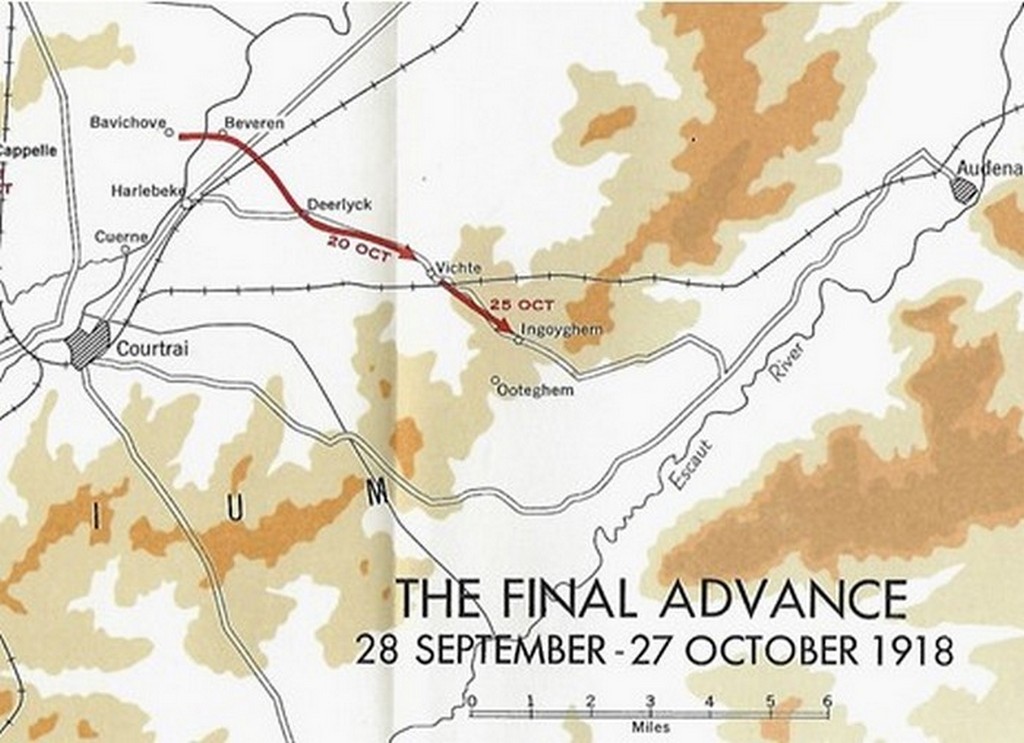Courtrai
The Regiment faced the river-canal Lys, about 150 feet wide and no shallower than 6 feet and with steep banks. The enemy was deployed on the east bank. At this time the Regiment was part of the 9th Division, Maj. Gen. Sir Hugh Tudor, commanding. (General Tudor was destined to eventually retire to St. John’s, and is buried in the Anglican Cemetery).
The plan was for two other battalions to lead the assault crossing the night of 19/20 October, with the Newfoundlanders following in reserve. First, several days were occupied in training and rehearsals, involving crossing waterways by boat, raft, or via narrow foot bridges in single file and fanning out into the bridgehead.
The night attack began at 11 PM on October 19. The lead battalions successfully fought their way across using rafts when the pontoon bridges, built and deployed by the Royal Engineers, were destroyed by enemy fire. The Newfoundlanders followed up at 4 AM, but they were forced to wade across on 18 inch duckboards submerged under 2 feet of water. Imagine the difficulty of feeling your way across a plank you could not see, carrying 60 pounds of kit, in the dark, under artillery and rifle fire.
In the morning of 20 October, the Regiment took over the lead and marched into Deerlyck where an ecstatic civilian population gave the men a rapturous welcome. Their next task however, was much less attractive. The Regiment was given orders to advance to Vichte, 3 miles east, and the Ingoyghem-Ooteghem ridge beyond.
The Regiment came under heavy fire after entering Vichte, and took up defensive positions. Their orders were to hold this position regardless of whether their flanks were secure, due to the flanking battalions being held up. Artillery and machine gun fire from the flanks made this position very dangerous. Casualties mounted to the point where there was only one unwounded officer per company. The Regiment held for 24 hours until relieved the evening of 21 October.
COURTRAI

Three days later, the Regiment was ordered forward from Harlebeke on the evening of 24 October. They assembled at farms near Vichte, where, terribly, an enemy shell found a barn where a whole platoon of D Company were in the process of vacating, and nearly all were killed. The 28th Brigade, of which the Regiment was part, was ordered the next morning to attack the Ingoyghem-Ooteghem ridge, the last barrier before the Scheldt River. The ridge was defended by two crack machine-gun battalions and supporting artillery. Ingoyghem was not taken until mid-afternoon 26 October. The strong defence stymied any attempts to take Ooteghem 1200 yards to the south. That afternoon the Regiment was ordered to patrol; however, the Regiment was recalled almost immediately, and the as soon as the patrols returned, the Regiment was relieved, going into billets at Bavichove near Harlebeke.
Since 28 September, when leaving Ypres at the River Lys, the Regiment had advanced more than 50 kilometres, and were utterly exhausted. Capt Syd Frost noted that on the night of 25 October, after occupying Vichte, his company fell asleep despite efforts to keep them awake. B Company was down to 46 soldiers.
Many Newfoundlanders reported regrets the Regiment did not make the final objective, the River Scheldt, about 600 yards away from Ingoyghem.
At Bavichove, well behind the lines, a stray shell wounded Pte R. Courage, the last casualty of the war for the Regiment.
